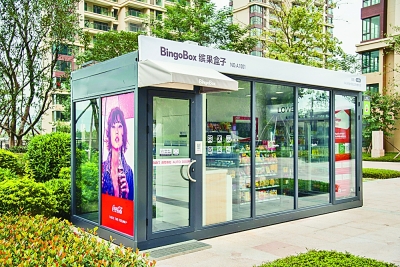Data management central to future retail market

BingoBox, a self-service store, is able to sell a range of items as a convenience store without cashiers.
“Self-service” retail is a testament to the technological progress that has enabled new methods of consumption. For example, information technologies can function as shopping assistants that help consumers make informed purchases, diversified payment systems are rendering cashiers obsolete, and facial recognition systems can better resolve security issues.
Though store workers are the most familiar aspect of retail, they have never really been the most important. A better understanding of self-service retail can be achieved from two perspectives: store layout serves as the surface feature while data management plays the fundamental role.
Consumers can easily notice the changes at a surface level and pay more attention to them. A much more subtle change is the use of smart product recommendations at Amazon or Alibaba online shopping that are based on browsing history and machine learning.
At the same time, vending machines for drinks or toys have already become a mature business model. To some extent, we can consider a grocery store without checkout lines to be an updated version of a vending machine. The fundamental difference between self-service groceries and vending machines for drinks is the ability to operate and manage a variety of items. The real problem is not the existence or absence of shop workers.
In terms of the circulation chain, retail shops are the most crucial way to get in touch with consumers while self-service shopping requires data-based optimization of the whole circulation chain. Two grocery stores that have identical appearances may have enormous differences in items, stock, circulation and layout due to divergent data storage and uneven ability to process it, leading to variations in turnover rate and profit.
Traditional retail industry depends largely on experience in shop management, but the key to future development is to use multi-dimensional data to optimize store operations. The “absence of people” is only a variation in this transformation. At this point, self-service retail is a data-driven product of advanced technology that relies on the ability to collect data and use it to guide retail store operations rather than a shop upgrade or a new profit model.
Self-service retail stores and giant companies with massive data resources and powerful data management, such as Amazon and the Alibaba Group, have a completely different development path to the smaller companies without these advantages. The current market requires more enterprises to join the transformation by making full use of their comparative advantages, thus boosting the retail market.
A way that fits all retail companies is to abandon the pattern of experience-based management and turn to data processing, which is future of retail. Self-service retail reflects the progress in the industry, but it is much more than the replacement of shop workers. It is short-sighted for companies to open self-service super markets with the sole intent of saving labor and management costs.
In the short term, the expansion of self-service stores may go through instabilities and hardships due to two issues. From the perspective of cost-benefit analysis, companies lack the incentive to invest in related technologies, including data collection and processing methods, especially when human costs are relatively low. Meanwhile, self-service retail only can be realized once data accumulation and usage has reached the point where it greatly improves sales efficiency. We have a long way to go to achieve this goal.
The prospects for new forms of retail are optimistic, and self-service retail is one crucial development trend. Companies should embrace the opportunity based on management ability and objectives while exploring consumer experience. In the future, more companies will emerge in the new retail market.

 PRINT
PRINT CLOSE
CLOSE